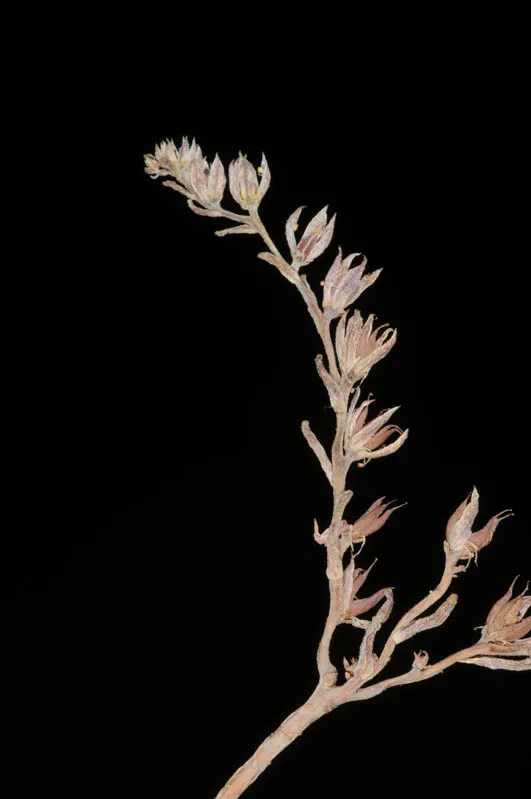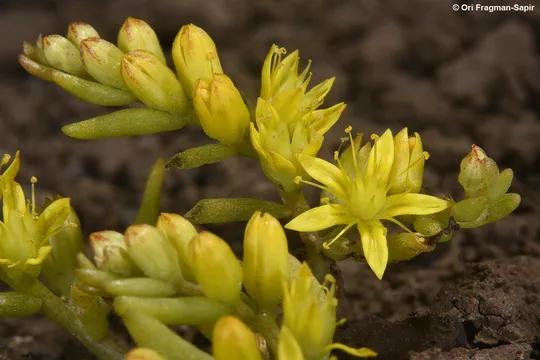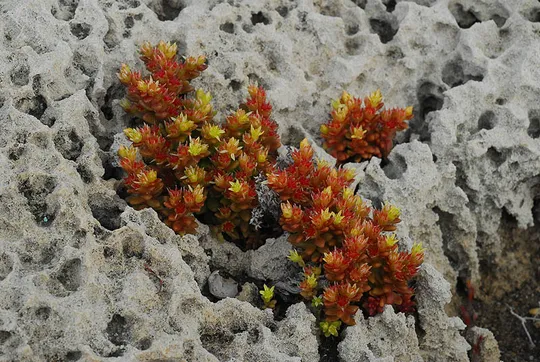Palestine Stonecrop
Sedum palaestinum

Sedum palaestinum is currently found in five regions: the Upper Galilee, Gilboa, Samaria, Judean Mountains and Judean Desert. Nine sites are documented in these regions and according to estimates; there are eleven sites in Israel. In the Upper Galilee, it is known only from Keren Naftali; in the Gilboa it grows on the northern slopes of the ridge, in Gid'ona and on Hohit Hill, but has become extinct from two more sites there. In Samaria, it was observed at Khirbat al Hrejma and in Nataf. The other sites are located in the Judean Mountains: Nes Harim, Tarqumiyah, Te'omim Cave, Wadi HaNativ (Caesar's Trail) and Wadi Carmila. In this region, it is extinct in Jerusalem. In the Judean Desert, it is found at En Para. It was collected and observed in the past from three other regions, but is now extinct: in the Lower Galilee it disappeared from Tiv'on, Kaduri, Eilabun, and Sejera; in the Carmel it is extinct in Haifa and Zikhron Ya'acov, in the Shfela it was not found again in the Hulda-Kiryat Gat area.
Moist rock pockets with shallow soil in the Mediterranean
region and in the transition zone.
The genus Sedum is the largest in the Crassulaceae
family, numbering about 420 species (according to some, 600 species, if we
include related genera that are occasionally considered as separate), mostly in
the temperate zone in the Mediterranean region, western and eastern Asia. As in
most of the genera in the family, its leaves are succulent and their photosynthetic
process is characteristic of the Crassulaceae family (CAM):
carbon dioxide absorption in the leaves occurs in darkness and fixation takes
place during the day, when the leaf stomata are closed. This mechanism is an adaptation
to arid conditions.
In Israel, including the Hermon, there are ten species of
Sedum, all in rocky habitats, particularly in shallow soil depressions and
rock crevices. Three of the species are perennial – S. laconicum, S.
sediforme and S. amplexicaule (Hermon). The remaining species are
annuals. S. palaestinum and S.
litoreum have yellowish flowers, while the other annual species have pinkish-white
flowers. The common species are S. rubens, S. hispanicum
and S. caespitosum.
Many Sedum species are used as ornamental plants
in rockeries and collections of succulent plants. The leaves of some European
and eastern Asian species are eaten in salads.
·
The number of regions and sites where Sedum palaestinum grows are constantly
declining and has been reduced by half compared to what was known in the past.
·
The reason for the population decrease
is not clear, since most of the sites are located in natural open spaces
(except possibly the sites in Jerusalem and Haifa, which probably disappeared
due to development).
·
S. palaestinum is protected in
the Upper Galilee in the Keren
Naftali
National Park and in the Judean Mountains in the Wadi Sorek Nature Reserve.
·
S. palaestinum is endemic to
Israel and Lebanon and its local threat level is equivalent to its global one.
Comprehensive search
surveys should be conducted in rocky habitats in Israel's mountainous regions
in order to obtain an updated status of this species, as, possibly due to its
modest size, it does not get enough attention and may also be difficult to
locate because of its rarity.
Sedum palaestinum is endemic to
Israel and Lebanon.
Sedum palaestinum is a small
annual plant of rock pockets in Israel's mountainous regions. It is becoming
rarer due to reduction in the number of known sites. The species is endemic to Israel
and Lebanon and its local threat level is equivalent to its global one.
Current Occupancy Map
| 1000 squre meter pixel | 5000 squre meter pixel | 10000 squre meter pixel | |
|---|---|---|---|
| number of observations | 0 | 0 | 0 |
| in total pixels | 0 | 0 | 0 |
| Family | Crassulaceae |
| Classification | On the endangered species list |
| Ecosystem | Mediterranean |
| Chorotype | Eastern Mediterranean |
| Conservation Site | Rocky limestone in Nes Harim area and up to the Te'omin Cave |
| Rarity |
1
3
6
|
|---|---|
| Vulnerability |
0
2
4
|
| Attractiveness |
0
0
4
|
| Endemism |
0
2
4
|
| Red number |
1
3.7
10
|
| Peripherality | 0 |
| IUCN category | DD EW EX LC CR EN VU NT |
| Threat Definition according to the red book | Vulnerable |
 Based on:
Based on:






